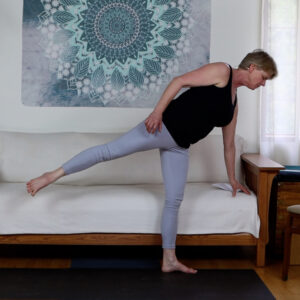
Open-hip standing poses offer a range of benefits for total hip replacement.
– They can be modified for any level of ability so that you can practice them at any stage of your THR journey.
– They build strength.
– They provide stability for your hips.
– They promote mobility in the hip joint.
But! Keen attention to alignment and using muscle strength to bring the legs into alignment is key to keeping the hip safe and to stabilizing the hip joint.
Examples of open-hip standing poses:
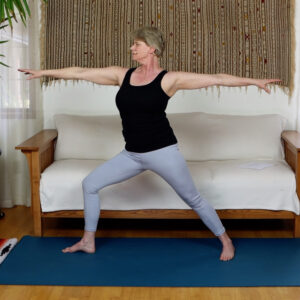
Warrior II/ Virabhadrasana II
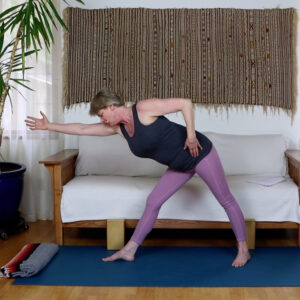
Triangle Pose / Trikonansana
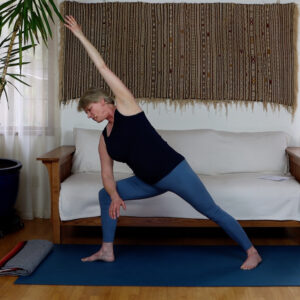
Side Angle Pose / Parsvakonasana

Half Moon Pose / Ardha Chandrasana
Open-hip standing poses benefit your hip joints in several ways.
They strengthen stabilizing muscles around the hip joint. Open-hip poses build strength in key muscle, specifically external rotators, that stabilize the hip joint.
They make outward rotation of the hip joint safe. The front leg in an open-hip pose actively engages external rotators of the hip joint. These muscles stabilize the hip in the socket and when they are strong they help to keep the joint firmly in the socket.
They keep the hip joint and the surrounding muscles flexible. Because open-hip standing poses require strength, this means you are providing stability for the joint as you move deeper in the pose to stretch muscles.
Start out small and go from there…
Following THR, your leg muscles may feel stiff or tight and you may feel you are not as mobile as you were before surgery. This is a natural response to the surgery and it can take time for your body to regain strength and mobility.
- As you practice standing poses start with a narrow stance and focus on feet leg and pelvis alignment before adding the upper body positioning.
- Hone your alignment
- Practice engaging stabilizing muscles
- Explore how the pose feels in this modest stance.
- When you feel confident take your legs wider.
Side Angle Pose / Parsvakonasana – narrow to wide stance:
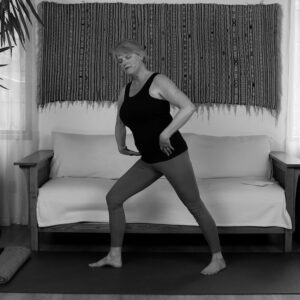
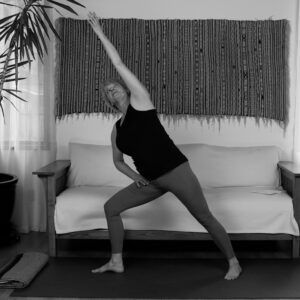
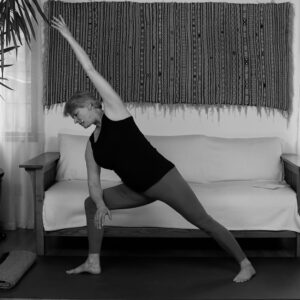
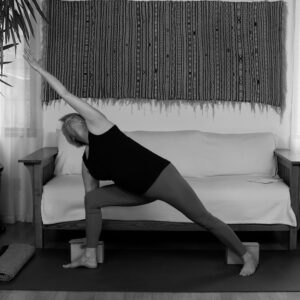
You will find detailed instruction on how to practice all the open-hip poses in the Standing Pose section of the website.
Thanks for reading!
Here’s to Healthy and Happy Hips!
Key Takeaways
- Open-hip standing poses enhance strength, stability, and flexibility after a total hip replacement.
- Modifications make these poses accessible at any stage of recovery.
- Proper alignment and muscle engagement are crucial for hip safety and joint stabilization.
- Poses like Warrior II, Triangle Pose, Side Angle Pose, and Half Moon Pose strengthen external rotators, which help keep the hip joint secure.
- Start small—begin with a narrow stance, focus on alignment, and gradually expand your range as confidence grows.
Frequently Asked Questions
Are open-hip standing poses safe after a total hip replacement? Yes, when practiced with proper alignment and modifications, these poses help strengthen and stabilize the hip joint while improving flexibility.
When can I start practicing these poses after surgery? Wait 6-12 weeks for bone and tissue to heal and consult your surgeon or physical therapist. Start with gentle variations.
What are some beginner-friendly modifications? Start with a narrow stance, use props like a chair or wall for support, and focus on engaging stabilizing muscles before deepening the pose.
Why is alignment so important in these poses? Proper alignment prevents unnecessary strain on the hip joint and ensures the muscles provide support and stability as you move.
How do these poses improve mobility? They improve mobility by building strength in external rotators to allow safe, controlled movement, gradually increasing flexibility over time.
Member Videos: Standing Poses, Feet, Legs, Pelvis Position in Open-hip Poses, Warrior II / Virabhadrasana II, Triangle Pose / Trikonasana, Half Moon Pose / Ardha Chandrasana
Non-Member Preview: Yoga Basics, Standing Poses
Free video: Yoga while healing from Total Hip Replacement Surgery: A safe post-op asana practice
Become a member of Yoga for Hip Replacement here
Articles and Studies:
Blog – “Healing from Total Hip Replacement and how yoga can help”
Blog – “Listen to Your Hands”
Blog – “Which Poses are Safe Following THR”
“Bone Healing, How Does Bond Heal”
“Hip Replacement, Mayo Clinic”
